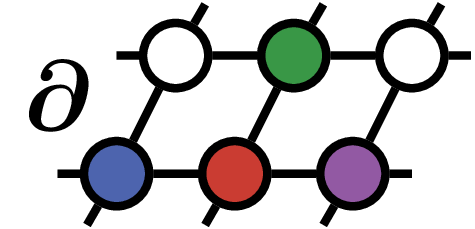under-Peter / Tensornetworkad.jl
Programming Languages
Projects that are alternatives of or similar to Tensornetworkad.jl
This is a repository for the Google Summer of Code project on Differentiable Tensor Networks.
In this package we implemented the algorithms described in Differentiable Programming Tensor Networks, namely implementing automatic differentiation (AD) on Corner Transfer Matrix Renormalization Group (CTMRG) and Tensor Renormalization Group (TRG), demonstrating two applications:
- Gradient based optimization of iPEPS
- Direct calculation of energy densities in iPEPS via derivatives of the free energy
More generally we aim to provide Julia with the tools to combine AD and tensor network methods.
Suggestions and Comments in the Issues are welcome.
Example
Since this package was inspired by the Differentiable Programming Tensor Networks paper, we demonstrate the usage of those algorithms in the following.
Free Energy of the 2D Classical Ising Model
We start by constructing the tensor for the tensor network representation of the 2d classical Ising Model.
This tensor can be constructed using the model_tensor-function that takes a model-parameter - in our case Ising() - and an inverse temperature β (e.g. at β=0.5).
julia> a = model_tensor(Ising(), 0.5)
2×2×2×2 Array{Float64,4}:
[:, :, 1, 1] =
2.53434 0.5
0.5 0.18394
[:, :, 2, 1] =
0.5 0.18394
0.18394 0.5
[:, :, 1, 2] =
0.5 0.18394
0.18394 0.5
[:, :, 2, 2] =
0.18394 0.5
0.5 2.53434
Using the trg function, we can calculate the partition function of the model per site:
julia> trg(a, 20,20)
1.0257933734351765
which grows bond-dimensions up to 20 and does 20 iterations, i.e. grows the system to a size of 2^20 which is well converged for our purposes.
Given the partition function, we get the free energy as the first derivative with respect to β times -1.
With Zygote, this is straightforward to calculate:
julia> using Zygote: gradient
julia> dβ = gradient(β -> trg(model_tensor(Ising(), β), 20,20), 0.5)[1]
1.7455677143228514
julia> -dβ
-1.7455677143228514
which agrees with the data presented in the paper.
Finding the Ground State of infinite 2D Heisenberg model
The other algorithm variationally minimizes the energy of a Heisenberg model on a two-dimensional infinite lattice using a form of gradient descent.
First, we need the hamiltonian as a tensor network operator
julia> h = hamiltonian(Heisenberg())
2×2×2×2 Array{Float64,4}:
[:, :, 1, 1] =
-0.5 0.0
0.0 0.5
[:, :, 2, 1] =
0.0 0.0
-1.0 0.0
[:, :, 1, 2] =
0.0 -1.0
0.0 0.0
[:, :, 2, 2] =
0.5 0.0
0.0 -0.5
where we get the Heisenberg-hamiltonian with default parameters Jx = Jy = Jz = 1.0.
Next we initialize an ipeps-tensor and calculate the energy of that tensor and the hamiltonian:
julia> ipeps = SquareIPEPS(rand(2,2,2,2,2));
julia> ipeps = TensorNetworkAD.indexperm_symmetrize(ipeps);
julia> TensorNetworkAD.energy(h,ipeps, χ=20, tol=1e-6,maxit=100)
-0.5278485155836766
where the initial energy is random.
To minimise it, we combine Optim and Zygote under the hood to provide the optimiseipeps function.
julia> using Optim
julia> res = optimiseipeps(ipeps, h; χ=20, tol=1e-6, maxit=100,
optimargs = (Optim.Options(f_tol=1e-6, show_trace=true),));
Iter Function value Gradient norm
0 -5.015158e-01 2.563357e-02
* time: 4.100799560546875e-5
1 -6.171409e-01 3.170732e-02
* time: 0.3943500518798828
2 -6.558814e-01 2.927539e-02
* time: 0.6722378730773926
3 -6.577320e-01 1.299056e-02
* time: 1.0529990196228027
4 -6.587514e-01 8.515789e-03
* time: 1.2889769077301025
5 -6.595896e-01 1.102446e-02
* time: 1.5059330463409424
6 -6.599735e-01 2.020418e-03
* time: 1.8917429447174072
7 -6.600449e-01 4.343536e-03
* time: 2.180701971054077
8 -6.601202e-01 2.623793e-03
* time: 2.5907390117645264
9 -6.602188e-01 3.951503e-04
* time: 2.9895379543304443
10 -6.602232e-01 2.597750e-04
* time: 3.254667043685913
11 -6.602246e-01 2.960359e-04
* time: 3.4899749755859375
12 -6.602282e-01 2.846450e-04
* time: 3.739893913269043
13 -6.602290e-01 1.679273e-04
* time: 3.9142658710479736
14 -6.602303e-01 2.155790e-04
* time: 4.230381011962891
15 -6.602311e-01 2.239934e-05
* time: 4.5699989795684814
16 -6.602311e-01 1.935087e-05
* time: 4.837096929550171
where our final value for the energy e = -0.6602 agrees with the value found in the paper.
License
MIT License



